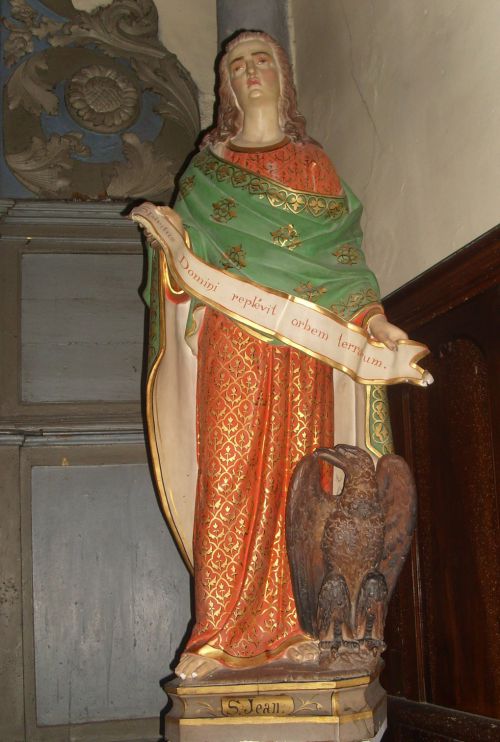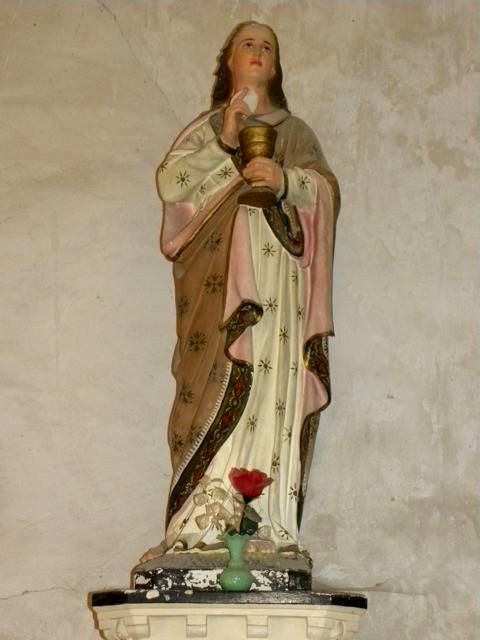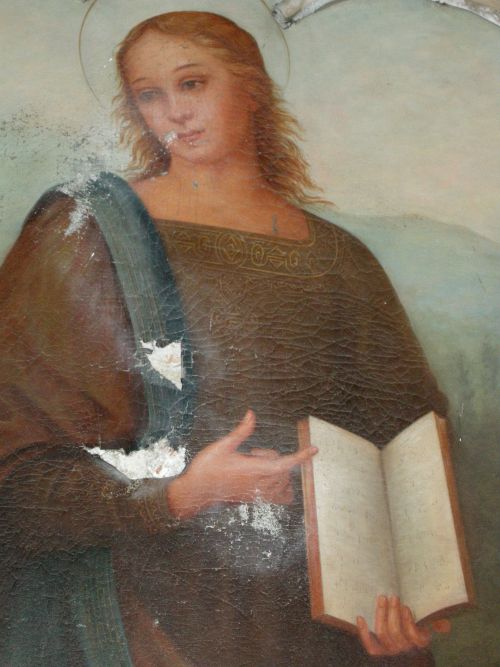Statues in COUNTRY CHURCHES
Learning what to look for
In Languedoc, and indeed, in the rest of France, are churches and cathedrals with paintings, statues and stained-glass windows of the saints. Many of them incredibly beautiful and some are of great historical interest.
There exisits an iconography, that is, a convention for representing the saints. Each saint has certain characteristics. These can vary a little or a lot.
Sometimes conventions change down the arches of the years, fashions change, new directives are issued by the Catholic Church. Sometimes it is not always possible to know which saint is intended. We non-Catholics, researching the saints, can sometimes get confused.
Hence this guide!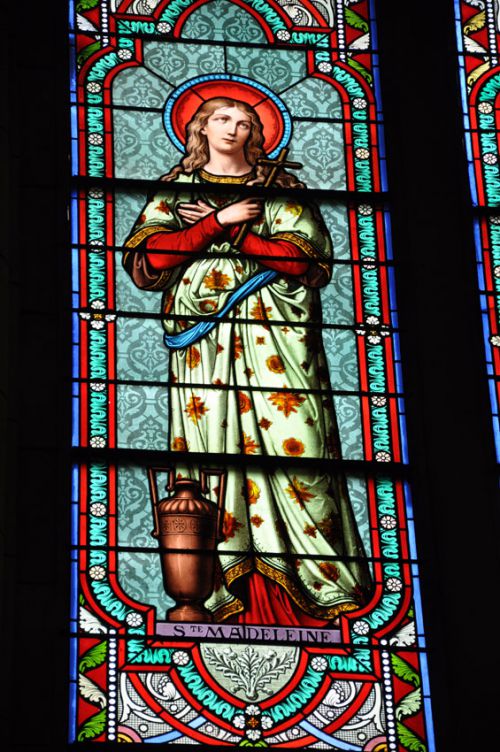
The first thing to look for is, fairly obviously, is a name, as we have Ste. Madeleine in this picture taken at Arlanc, near Clermont-Ferrand. Other parts of the icongraphy are there; the alabaster jar, from which she anointed Jesus, at her feet, and a crucifix which she holds. The crucifix is symbolic; the early church never used images of crucifixes; but it is a stardard depiction for Mary Magdalene.
She has long wavy hair, uncovered, of a reddish tint, this too is standard, and many think that a red coloured robe or dress signifies her, but this is variable. The way the dress is bunched about her middle implies a pregnancy, but whether the artist intended this or not is another point!
However, this window is quite young, as we can see by the name, for Maria Magdalena became Marie Magdeleine after the Revolution, and then the “g” was dropped in the twentieth century.
Some iconographic items are missing too; the skull and the book. These are usually depicted in the “penitent” images of her, often naked or half-naked in a cave, but not always. Another missing iconographic item is her hands clasped and her fingers interlocked in a curious way.
The arms crossed at the wrist in this manner sometimes used, but not often, and the pious expression with the eyes raised to Heaven, is not typically Mary Magdalene, but is reminiscent of the Virgin Mary.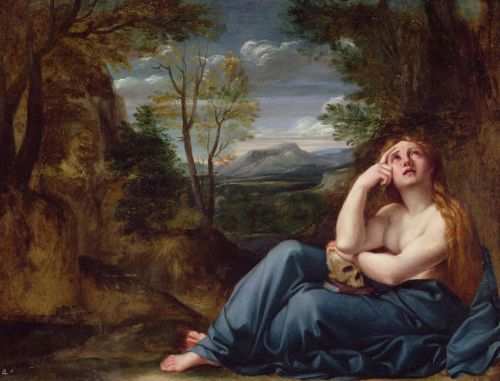
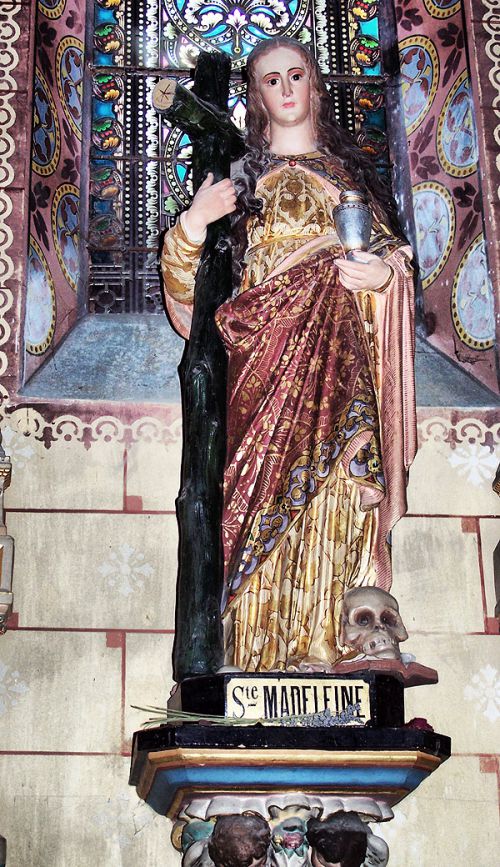
You can see the book and the skull in both these pictures.
Below, is a very “human” representation of the saints. For a long time I thought, because of the obvious flurry of servants in the background, that this was a picture of the Marriage at Cana and the bride, because of her crossed arms, could not have been Mary Magdalene. But she was, for the title of the picture was “In the house of Martha” and represents the scene where Martha complains at the pressure of housework while Mary Magdalene receives spiritual teaching from Jesus. The picture is lovely for its very human representations of the characters, and also lets us know that the house of Simon in Bethany was quite a wealthy household with many servants.
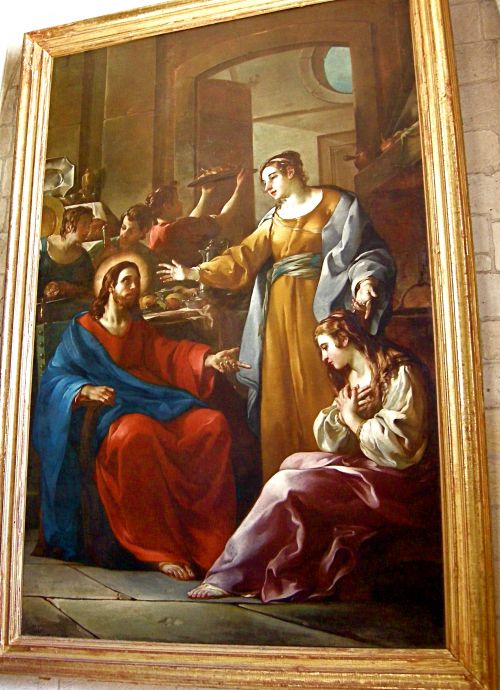
For a discussion about whether Jesus and Mary Magdalene were married, click here.
Meanwhile, here’s two representations of the scene which seem to be their marriage. The first one shows the stained glass-window in the church of St. Martin, in Limoux. The regular church people say it represents Jesus and his mother, but the majority of people who see it instantly think it is the marriage of Mary M and Jesus. What convinced me were the saints at the bottom of the picture - they are all women.
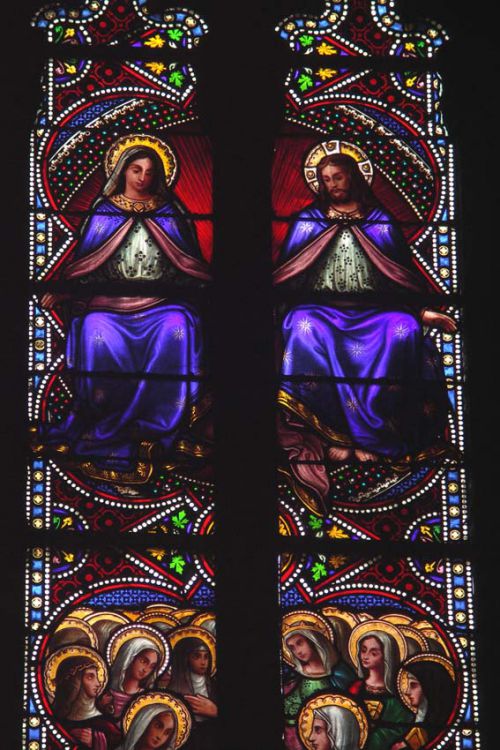
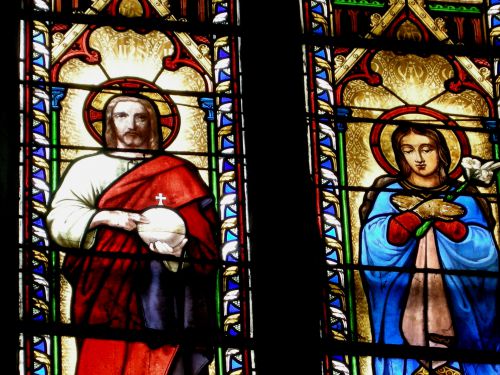
The second picture was taken at the church of Pexiora, between Castelnaudary and Bram, in the Aude. At first sight the lady’s long wavy hair makes us think this is Mary Magdalene, and again we see the gesture of the crossed wrists - but she holds a lily. A lily in church iconography is a sign of virginity, and until 1969 Mary Magdalene was considered to be - a sinner. Mother Mary remained forever virgin, the Church said so. (We often also see St. Joseph holding a lily - he married the Virgin Mary but was obliged to remain ever virgin himself - and also St. John, the Beloved Disciple, as well as various other saints, like St. Anthony the hermit and St. Anthony of Padua.) But for real clarification look for the name - above Jesus’s head are some initials, INRI, (and he holds a globe to tell us he is the King of the World) while above Mary’s head is a symbol that only ever relates to her and is often seen - here’s a picture of it below the statue of the Virgin in the garden of the church at Rennes-le-Château, look at the bottom plinth.
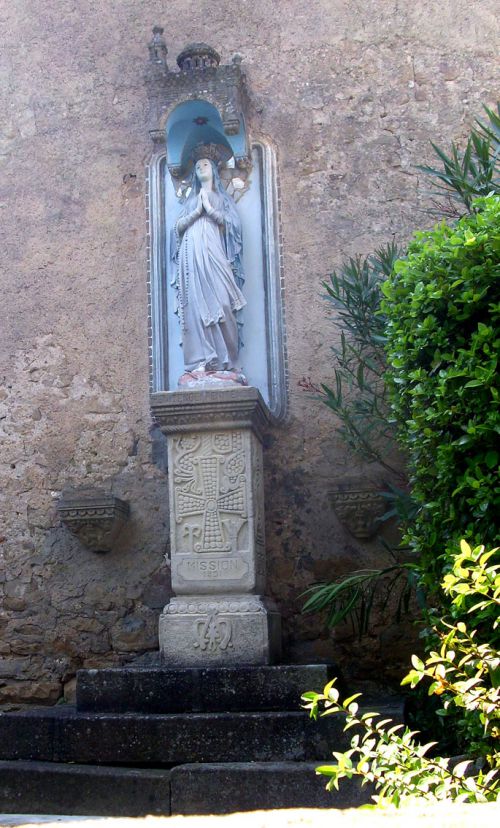
The most common confusion is between the two Marys, especially in older images. Right up until 1874 in France, where primary education became compulsory as it did in England, few people could read and write. They knew only what the church images and the priest told them. In early days churches were dedicated to Mary without saying which Mary it was, and then clarifications were made later.
I must add though, that the cult of the Virgin Mary was more widespread thoughout France than that of Mary Magdalene. More churches and cathedrals are devoted to her than any other saint, and some churches, such as Tuchan in the Corbières, carry no images of Mary Magdalene at all, except for a few reluctant appearances in the Stations of the Cross, and even these vary; some churches have less than others. I have seen many paintings of the crucifixion in churches that show no Mary Magdalene at all.
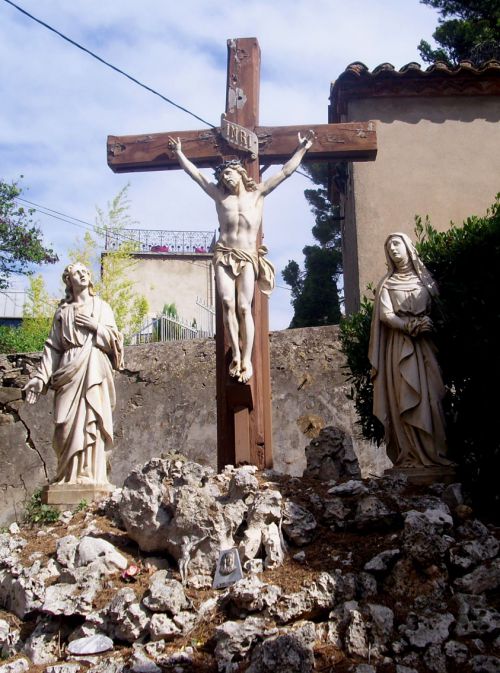
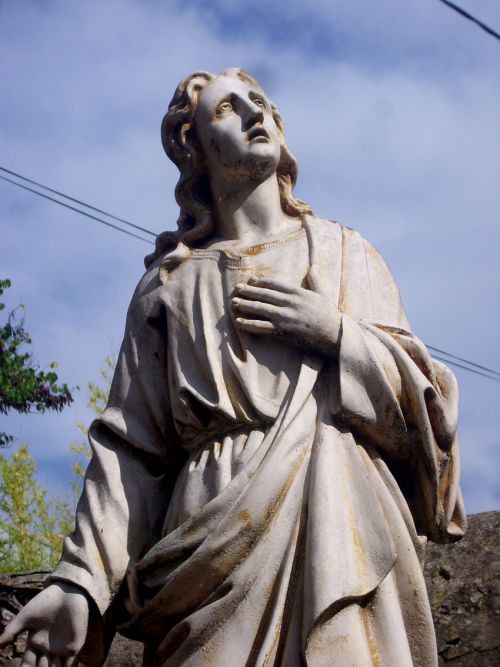
The above pictures were taken in a village graveyard near my home. At first it seems that Mary Magdalene IS there; but no, that statue shows not Mary, but “St. John the beloved disciple” that we now know was Lazarus (Click here for my article about Lazarus.) The image is of a young man; he often has a square jaw, a flat chest and large hands. Sometimes he has an eagle with him, which was a sign of St. John, or a book because he wrote one, and sometimes he carries a lily, or holds two fingers up as a blessing, or both. He has long hair and this is the thing that makes him look the most like Mary Magdalene; the story goes that in Judea a boy’s hair was not cut until he reached his Bar-Mitzah, which made him officially a man, but I am not sure about this.
These are all, even the last, representations of St. John, taken at Tuchan in the Corbières, Quintillan in the Corbières, and the cathedral of St Etienne at Toulouse.
He was present at the crucifixion, and many pictures show him there; in this picture from Rennes-le-Chateau, you can see a classic representation of the three; Mary the Virgin, with her eyes piously to heaven and her palms spread in front of her, St John, and Mary Magdalene. Then another picture from Nebias of the same scene.
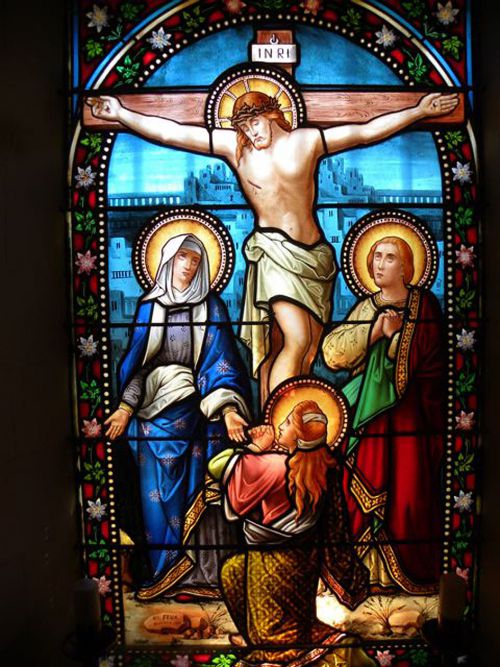
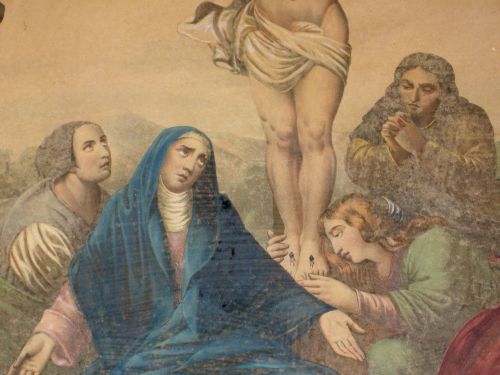
Please note that in the first, both Mary Magdalene and John have their fingers interlocked in typically Mary M fashion - but in the second picture, only St. John does so! You will also note another lady represented here - Mary Salome. She was the mother of the fisherman saints, John and James, sometimes known as “the wife of Zebedee," their father, and she was a special friend to Mary Magdalene. She was supportive during the crucifixion and a concept exists among Catholics here of “The Three Marys.” They are always Mary the Virgin, Mary Magdalene and Mary Salome. (Mary was a very common name in Biblical times.) They were at the crucifixion in St. Matthew, St. Mark, but they are just called “the women” in Luke - he probably didn’t even know who they were, for he was a disciple of Paul and wasn’t anywhere near the scenes he describes.
It is indeed bizarre that some churches miss Mary Magdalene out of the crucifixion scene. Sometimes they miss her out of the “Mis-en-tombeau” scenes where Jesus was placed in his tomb; but St. John is always there. No wonder we sometimes confuse Mary Magdalene and St. John.
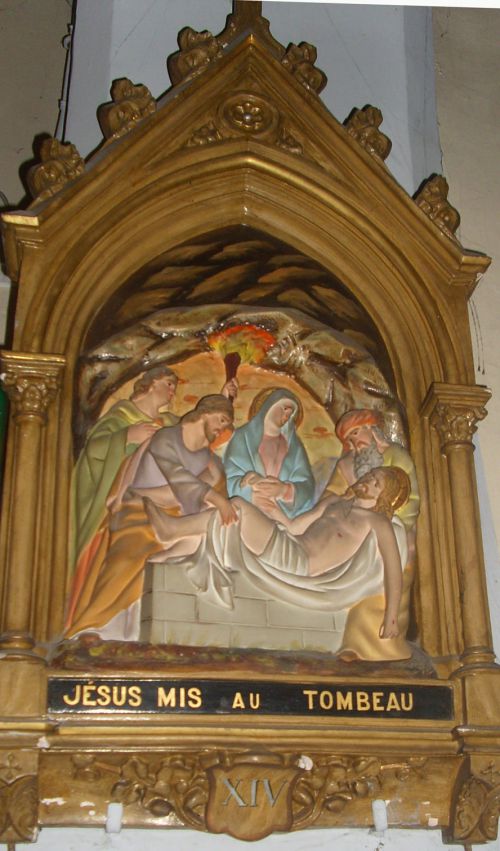 At Tuchan, Mary M is not there; it is St John holding the lamp
At Tuchan, Mary M is not there; it is St John holding the lamp
It used to make me angry, this apparent denial of Mary Magdalene and the role she played in events. I researched it quite closely and now think it was a fashion thing; around 1860 to 1890 the lack of her image was at its peak. That is something that makes the little church at Rennes-le-Château so amazing; the priest constructed it as he did not because it was fashionable, but because he loved Mary Magdalene.
I have wandered from my purpose a little; but I hope you find these notes helpful when you visit French country churches.
With many thanks to Jaap Rameijer for the use of his photographs.
Inscrivez-vous au site
Soyez prévenu par email des prochaines mises à jour
Rejoignez les 261 autres membres

